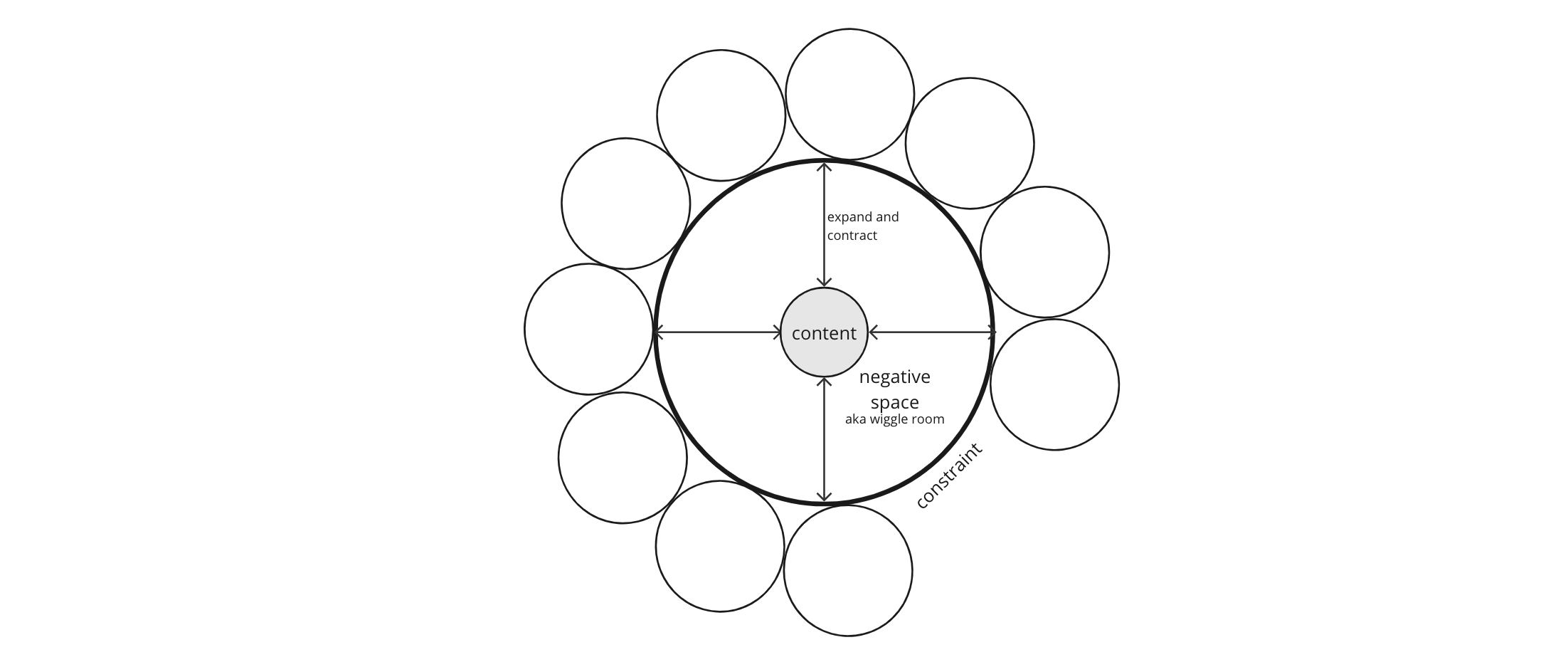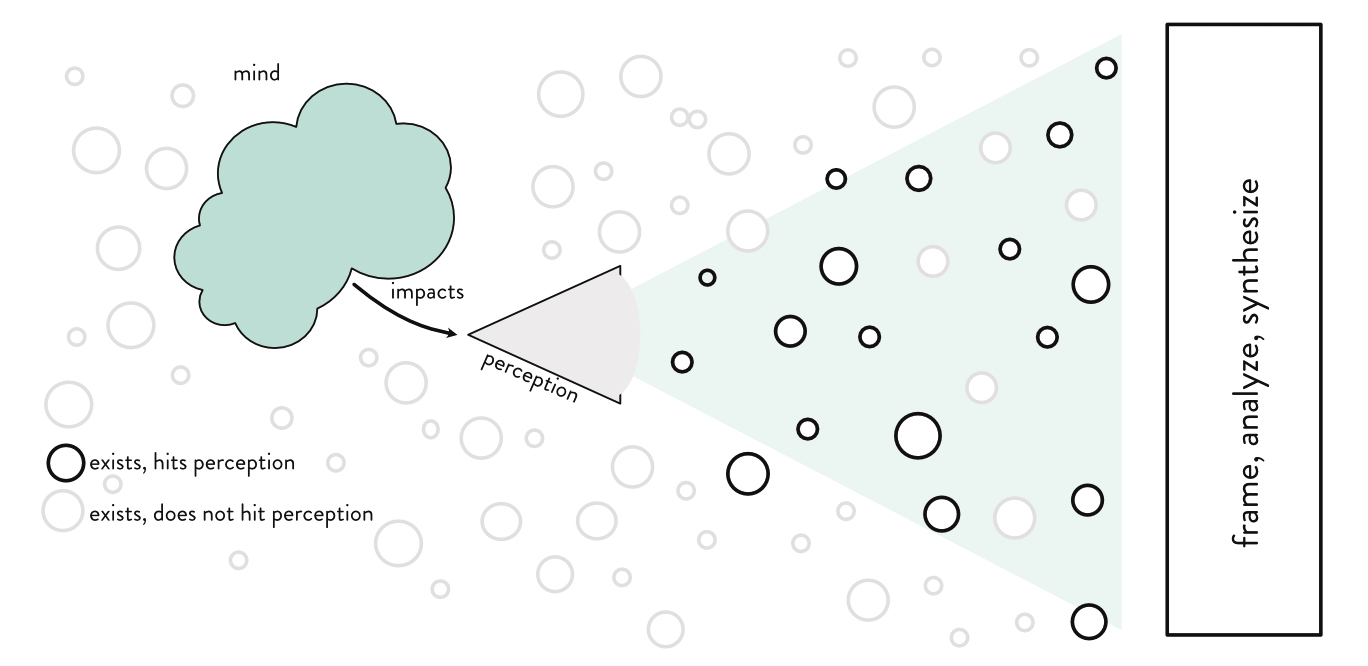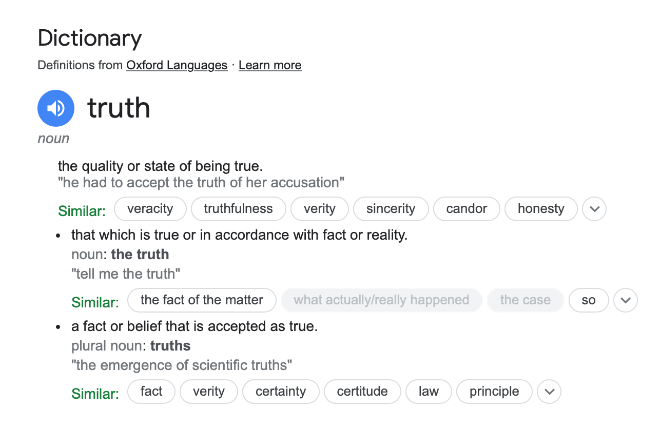Systems expand and contract
Why does the push/pull of systems happen?
There is volume involved between and within the nodes of a system. Inside the node, in the liminal space around the node that allows/constrains the potential for expansion, in nodes that will be supplying volume through flow, and in the nodes expecting volume to be passed.
It’s more than simple volume. It’s content and wiggle room, and the ability/need to expand and contract the contents. They don’t stay the same. The data can be reallocated out to a different location, or live in mirrored multiplicity, or dissipate into misinformation. But usually, more data are added. And added, and added some more, because our universe is in a state of expansion, and people are nowhere near catching up.
A system with different sizes of nodes already feels more nuanced and potentially meaningful depending on what data it’s documenting. Now think of every big dot as potentially too small to register, and every small node potentially as big as a neighbor. Imagine a node currently too small to register as suddenly having more data than the combined documented system.
What you see in the first graphic is true; what you see in the second graphic is true. They are simply in different moments of time.
That’s what I mean by expanding and contracting.
Physical model: breathing
We live every day, every moment, with a biological system of content expansion and contraction.
We breathe. Our lungs expand. Our lungs contract. During that time they have a fungible volume of air, of which we are depending on a very specific fractional part of it. If we stop breathing, we die. If there’s not enough oxygen in the mixture, we die. If there’s too much of a noxious element or chemical, we die.
Oxygen, carbon dioxide, nitrous oxide, sulfur: they are all contents. In terms of our lungs, the contents are the contents: we can’t pick and choose. We pull in from outside the node to replenish the inside of the node. And then that node — our lungs — supply the contents to areas that don’t have direct access to the outside but still need the contents.
Our lungs, like so many models, can only expand so far, curtailed by both their own and adjacent space constraints. Databases have to change code to accept more records, art museums have more pieces than they have the physical space to show, kitchen cabinets can only hold so much. Imposed constraints are the norm. Even negative space requires space.
Negative space is the wiggle room. In our lungs every bud of alveoli circumscribes the negative space that can be filled. The space potential is pre-allocated.
Our world is similarly pre-allocated, but with so much wiggle room historically that we used to be able to pretend it was infinite. For the simple reason that we couldn’t use all the resources in our immediate space, we act like there’s greener pastures over the horizon. That is no longer the case.
Information model: perception
Information and human behavior are inextricably linked, yet the first point of impact is a function of information expansion and contraction: perception.
We don’t perceive everything. There is information available beyond what our senses can recognize, but more than that we have a limited space for what information can actually be managed by our mind at any given moment.
We are always allowing more information in. We hunger for it, because it is the key to making decisions and decisions preclude survival.
The experience of too much information is overwhelm, and our world is overwhelming these days. To manage this, we have a tendency to adhere to known pathways: roads we travel every day, places we visit regularly, brands we recognize, news outlets we prefer, people we’ve developed a rapport with. We do this so we have more bandwidth to accept new information.
New information is constant, even in our regular pathways. We have to refigure the roads we take to avoid congestion and broken infrastructure. Curiosity sparks on seeing a new coffee shop or beautiful object and we add a new, potentially temporary, place to be. We are impacted continually by marketing: brands who are trying to become recognized so you turn to them the next time you make a purchase; or who want to supply something that you didn’t know you needed, so they are trying to educate you of your lack. People in or adjacent to our social circles share news that may or may not come from a reputable source; pushed often enough it sparks recognition and hits a higher level of trust.
If you live in a city, most of the people you see in a day will be strangers. No rapport, no history-based understanding, yet you still need to navigate interaction to greater or lesser degrees. Some strangers will erupt in anger for a passing expression. Some strangers will ignore someone even if they are in physical distress. There’s no telling before the point of potential impact passes. Live in a city long enough, and you’ll understand that most people will ignore you most of the time, yet if either has an expressed need for interaction most will tentatively be open until they hear the why and can make a real decision.
Those who live in a city, in other words, keep their perception of other people constrained until there is a force that instigates expansion.
New information is a constant outside our pathways, too. It’s so constant we make the regular pathways, not only in our habits and routines, but in how we approach the world and what we’re likely to allow in to take space in our attention.
We contain the everyday to be able to use what negative space we can muster to deal with the unexpected pieces of our world. Like our lungs, there’s only so much time, attention, and cognitive space to use. Once we expand it with content, the content has to contract before we can take in more.
In the great beyond-our-mind, reality will continue to churn. Lightening strikes. Urgent work needs erupt that must be managed immediately. Your kid gets sick. New viruses hit our species and tear through our society.
We need time to make sense of things, organize, and nuggetize (store information dimensionally) so we can make room for more. It’s a contraction. If we take that time, our minds can expand.
Social model: Pandemic
We’ve all recently lived through a system whose primary social function was expand/contract: the pandemic.
We defined our boundaries, not just on an ad hoc basis but through a significant chunk of time. Within those boundaries we allowed a certain group of people. It was family, it was work, it was friends and pods — but each of us tried to keep track of who it was we interacted with more closely, for more time, and especially within a closed space.
We even grew to understand that each of us didn’t belong to just one group, but multiple groups. With each person in our group, we were actually interacting, also, with persons they had interacted with. The speed of viral transfer was in the span of minutes, but the speed of infection was in the span of days. You were, ultimately, interacting with not only who was in the room today, but every person in every room they were in during the past 10 days.
Think about it in terms of expansion. The current group expands as each person enters a room. As each person enters, they are creating a connection to previous groups they had interacted with, instigating a mirrored multiplicity. Because that multiplicity’s actionability was dependent on an unknown inclusion of living virus in their system, all the people in the second-degree group had to be included. The same mirrored multiplicity was included for each of the members of that group, and on down the line, until they hit that 10-day history mark.
Think about it in terms of contraction. The current group contracts as each person leaves, and if the duration was short enough and people stood far enough apart or were really good about their protective gear, as they left the mirrored multiplicities left with them. The longer they stayed, the more residue remained from those multiplicities. If there was no virus, the inclusion of all the adjacent groups dissipated into non-information.
People who interacted with more groups had a higher probability that they’d run into the virus, thanks to all these mirrored multiplicities. People who kept interactions short and spaces wide — putting wiggle room between — could mitigate a significant chunk of risk. Put the group outdoors, where the simple volume was huge, and the time factor could increase.
All of this was dependent on human behavior. We do, generally, understand the idea of expansion and contraction and how that ultimately mitigates or exacerbates virus transmission — in gut instinct if not this particular framing. Yet certain of us could not accept it. This is the impact of human behavior in the pandemic.
The reason why I wrote flow first is because the information architecture portion focused on communication. That communication flow impacts human behavior enormously. Communicated information significantly impacted how people dealt with the expansion and contraction of their pandemic pods.
People choose to listen to some communication (expansion), and dismissed other communication (contraction). That expansion and contraction of accepted communication affected the information they included as they navigated their lives.
Some people accepted/dismissed information and labeled them, respectively, truth/lies. The reality of the truth/lie label was itself another variation on expansion/contraction of their chosen cultures. Those cultures simplified their acceptance of information as truth or lie depending on their prioritization. What made their priority easy to decide: truth. What made their priority complicated: lie. The underlying meaning of the taxonomy became, “I willingly include this information in my decision making.” This is a a significant shift from, “that which is in accordance with fact or reality,” and a subtle shift from “a fact or belief that is accepted as true.” The meaning expanded to willing acceptance, and then contracted to leave out the once-primary characteristic of accordance with fact or reality.
Primary definition: the quality or state of being true.
Secondary definition: that which is true or in accordance with fact or reality.
Tertiary definition: a fact or belief that is accepted as true.
This idea of expansion and contraction of the information included is also how people decide to focus in their systems. We have a tendency to choose what’s important to us, and ignore the complications. We draw a line in the sand to say this system is included in our problem set, and that system is excluded. When this happens, it’s not because we’re defining the system inclusion based on the solving a problem set, but because we are oriented towards a goal. We’re removing “edge cases”.
Always it’s because there is no end to the system; reality goes on and on. Often it’s also because including that next-step system space is enough complexity to make the decision they want to make, not such a good decision after all. By cherry picking the system inclusion, people solve towards a goal.
Human behavior impacts the expansion/contraction of taxonomy, information, goals, and systems. The side effects of inclusion/exclusion surfaces most easily in top-built hierarchical structures, but even systems thinking can lead to racism, agism, sexism, etc., through this function of expansion/contraction. The function itself is something that we have to consider all the time.
Systems thinking
Systems thinking is not an instant, immediate curative to short-sighted decision making and reality building. The network structure it’s grounded in is leaps beyond other information structures in being able to understand how data is connected, but it is still curtailed by human behavior.
People are adaptable, creative, problem-solving glories of innovation, in environments that spark deviating from their particular ouruborus of perception. What problems we decide are problems, how we approach solving them, and how long we keep at it, are all patterns of decision making. Every decision can impact our perception, and our perception impacts decisions. That includes even the decision whether or not to see that what they’ve “always” done is causing distress in adjacent parts of the system. All the data in existence won’t save humanity if it can’t get past that primal barrier.
That barrier comes up iteratively as our understanding is being built, and it doesn’t suddenly shut off when we embrace systems thinking. If anything, it can get more truculent as we try to keep our information in a reasonable cognitive load.
Expand and contract. What is contracted (nuggetized) needs to be periodically expanded, too, and reviewed with critical thinking. That critical thinking has to include new information and understanding, not just review to ensure the accepted process was followed.
Expand and contract. The system we “always knew” can be reconfigured with the addition and subtraction of information. It might be as simple as recategorization, but it still results in a system that’s not immediately recognizable. People will default to their knowns even in the face of extreme cognitive dissonance if it means they can take action and feel in control of their lives, especially when stressed.
The primary outcome of expansion and contraction is change. Change is the only universal constant. It is beyond our capacity to halt, try as some of us might. Even if we can concretize and remove the quality of expansion/contraction in one space for a period of time, the stress of it cascades into adjacent systems until the overarching system forces a rebalance. Just like our bodies gasping for breathe, the larger whole forces the change it needs in order to find balance.
encapRD, failing information states, garbage-in, network, nodes, nuggetize, ouruborus, perspectives, prioritization, reductionism, system connectome, system resources, taxonomy, time, top-down







